Astronomy/Earth orbits
< Astronomy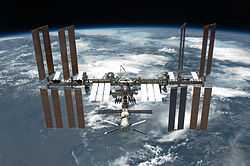
Detector systems may be launched for extended periods either for suborbital Earth astronomy or Earth-orbit astronomy.
Lofting an observing system into an orbit around the Earth requires designing and testing for survival of the rocket trip upward and the orbiting technique (usually a second stage for orbital insertion).
Satellites
Def. “[a] man-made apparatus designed to be placed in orbit around a celestial body, generally to relay information, data etc. to Earth”[1] is called a satellite.
International Space Station
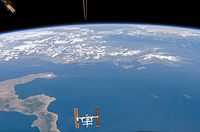
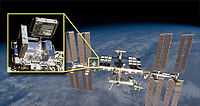
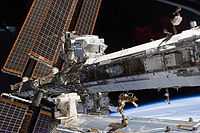
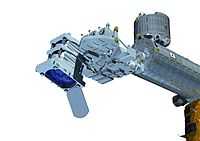
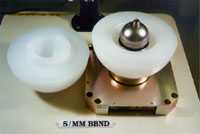
On the top right of this page is the International Space Station after the undocking of STS-134 Space Shuttle.
The Space Shuttle Endeavor crew captured this shot [on the left] of the International Space Station (ISS) against the backdrop of Planet Earth.
"Since 2001, NASA and its partners have operated a series of flight experiments called Materials International Space Station Experiment, or MISSE [on the second right]. The objective of MISSE is to test the stability and durability of materials and devices in the space environment."[2]
The Alpha Magnetic Spectrometer on the second left "is designed to search for various types of unusual matter by measuring cosmic rays."[3]
"The Extreme Universe Space Observatory (EUSO) [on the third right] is the first Space mission concept devoted to the investigation of cosmic rays and neutrinos of extreme energy (E > 5×1019
eV). Using the Earth's atmosphere as a giant detector, the detection is performed by looking at the streak of fluorescence produced when such a particle interacts with the Earth's atmosphere."[4]
On the lower left is a Bonner Ball Neutron Detector "BBND ... determined that galactic cosmic rays were the major cause of secondary neutrons measured inside ISS. The neutron energy spectrum was measured from March 23, 2001 through November 14, 2001 in the U.S. Laboratory Module of the ISS. The time frame enabled neutron measurements to be made during a time of increased solar activity (solar maximum) as well as observe the results of a solar flare on November 4, 2001."[5]
The Space Environment Data Acquisition equipment-Attached Payload (SEDA-AP) aboard the Kibo (International Space Station module) "measures neutrons, plasma, heavy ions, and high-energy light particles in ISS orbit."[6]
Skylab
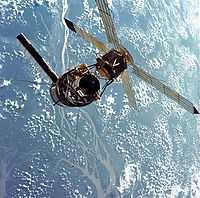
"The student experiments performed on Skylab 3 included ... neutron analysis."[7]
Van Allen probes
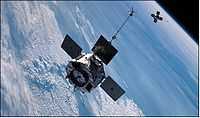
"The Radiation Belt Storm Probes [RBSP, NSSDC/COSPAR ID: 2012-046A, now the Van Allen Probes] mission is part of NASA's Living With a Star Geospace program to explore fundamental processes that operate throughout the solar system".[8]
Aeronomy of Ice in the Mesosphere
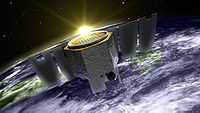
"The scientific purpose of the Aeronomy of Ice in the Mesosphere (AIM, [NSSDC/COSPAR ID: 2007-015A]) mission is focused on the study of Polar Mesospheric Clouds (PMCs) that form about 50 miles [60 km] above the Earth's surface in summer and mostly in the polar regions."[9]
Theoretical Earth-orbit astronomy
Low-earth orbit and geostationary orbit are two extremes.
Swarms
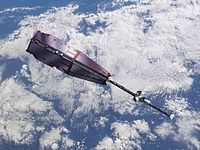
"Three [Swarm] satellites of the European Space Agency (ESA) have measured the magnetic field of Earth more precisely than ever before."[10]
Resurs-DK1
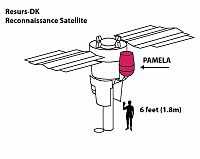
The Payload for Antimatter Matter Exploration and Light-nuclei Astrophysics (PAMELA) "is an operational cosmic ray research module attached to"[11] the Resurs-DK1 commercial Earth observation satellite.
HEAO 3
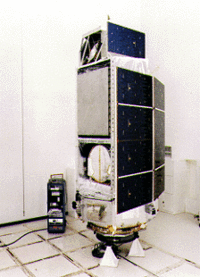
The "HEAO 3, launched on 20 September 1979 ... carried [an experiment] known as C1, [which] was a cryogenically cooled germanium (Ge) high-resolution gamma-ray spectrometer".[12]
Explorer 45
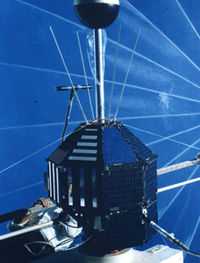
Explorer 45 (1971-096A) is a "NASA Small Scientific Satellite, S3-A ..., launched [using a Scout rocket on November 15, 1971,] from [the San Marco Platform,] Kenya, Africa, into an elliptical orbit having an apogee of 5.24 RE [27,031 km], a perigee of 220 km, an inclination of 3.5°, [eccentricity of 0.66982,] and a period of 7.82 hours. ... [carrying] two proton detectors and a three-axis fluxgate magnetometer. ... The lower energy proton instrument consists of an electrostatic analyzer-channeltron configuration measuring proton energies from 0.8 to 30 keV in 16 energy intervals."[13] Data stream ended on September 30, 1974,[14] and the satellite re-entered Earth's atmosphere on January 10, 1992.[15]
Interstellar boundary explorers
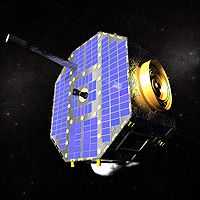
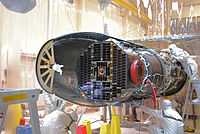
"The sensors on the IBEX spacecraft are able to detect energetic neutral atoms (ENAs) at a variety of energy levels."[16]
COMPTEL
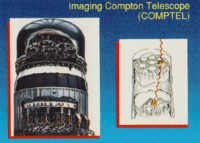
"In addition to observing gamma rays from a solar flare, [ the Imaging Compton Telescope] COMPTEL is also capable of detecting solar neutrons."[17]
INTEGRAL
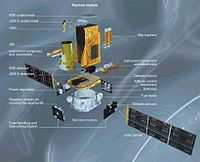
"[P]ositron astronomy results ... have been obtained using the INTEGRAL spectrometer SPI".[18]
Velas
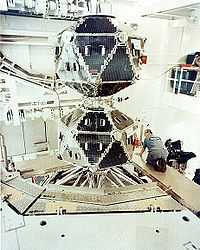
For gamma-ray astronomy, "the Vela satellites were the first devices ever to detect cosmic gamma ray bursts."[19]
Fermi Gamma-ray Space Telescope
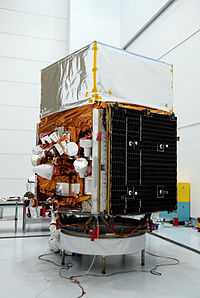
"The Large Area Telescope (LAT) [of the Fermi Gamma-ray Space Telescope ] detects individual gamma rays using technology similar to that used in terrestrial particle accelerators."[20]
Explorer 11
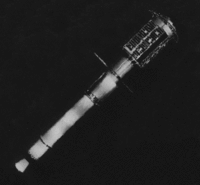
"Explorer 11 (also known as S15) was an American Earth-orbital satellite that carried the first space-borne gamma-ray telescope. This was the earliest beginning of space gamma-ray astronomy. Launched on April 27, 1961 by a Juno II rocket the satellite returned data until November 17, when power supply problems ended the science mission. During the spacecraft's seven month lifespan it detected twenty-two events from gamma-rays and approximately 22,000 events from cosmic radiation."[21]
Astro‐rivelatore Gamma a Immagini LEggero
"AGILE (Astro‐rivelatore Gamma a Immagini LEggero) is an X-ray and Gamma ray astronomical satellite of the Italian Space Agency (ASI). [The] AGILE mission is ... to [observe] Gamma-Ray sources in the universe. ... AGILE’s instrumentation combines a gamma-ray imager (GRID) (sensitive in the energy range 30 MeV-50 GeV), a hard X-ray imager and monitor: Super- AGILE (sensitive in the range 18-60 KeV), a calorimeter (sensitive in the range 350 KeV-100 MeV) (MCAL), and an anticoincidence system (AC), based on plastic scintillator. AGILE was successfully launched on [April 23,] 2007".[22]
Solrad 1
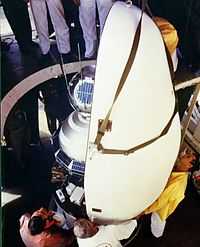
“The SOLar RADiation satellite program (SOLRAD) was conceived in the late 1950s to study the Sun's effects on Earth, particularly during periods of heightened solar activity.[23] Solrad 1 is launched on June 22, 1960, aboard a Thor Able from Cape Canaveral at 1:54 a.m. EDT. As the world's first orbiting astronomical observatory, Solrad 1 determined that radio fade-outs were caused by solar X-ray emissions.[23]"[24]
Solrad 3
.jpg)
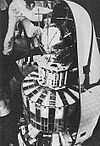
At left is an early X-ray observatory (Solrad 3), the spherical silver ball with antenna, atop a stack of satellites, being fitted with a nose cone to reduce atmospheric drag and to protect the satellites.
At right is the Thor Able Star rocket being launched by the US Air Force from Cape Canaveral, Florida, USA.
Solrad 3 is operated by the US Naval Research Laboratory beginning with its launch on June 29, 1961, through to the end of its mission on March 6, 1963. Although Solrad 3 did not successfully separate from the satellite immediately below it in the stack (Injun 1), it successfully returned solar X-ray data until late in 1961. It is not expected to re-enter the Earth's atmosphere for ~900 years.
European X-ray Observatory Satellite
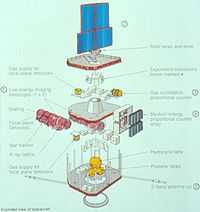
Exosat is capable of observing an object (in the direct-pointing mode) for up to 80 hours and of locating sources to within at least 10 arcsec with the LEIT and about 2 arcsec with GSPC.[25]
Chandra X-ray Observatory
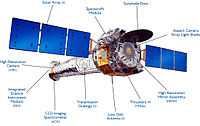
On the right is a pictorial diagram for the Chandra X-ray Observatory, NSSDC ID 1999-040B, of some of the major satellite systems.
Array of Low Energy X-ray Imaging Sensors
"The Array of Low Energy X-ray Imaging Sensors (ALEXIS) X-ray telescopes feature curved mirrors whose multilayer coatings reflect and focus low-energy X-rays or extreme ultraviolet light the way optical telescopes focus visible light. ... The Launch was provided by the United States Air Force Space Test Program on a Pegasus Booster on April 25, 1993.[26]"[27]
Far Ultraviolet Explorer
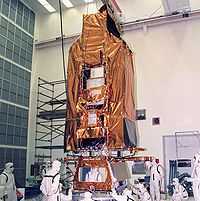
"The Far Ultraviolet Spectroscopic Explorer (FUSE) ... detected light in the far ultraviolet portion of the electromagnetic spectrum, between 90.5-119.5 nanometres, which is mostly unobservable by other telescopes."[28]
Hubble Space Telescope
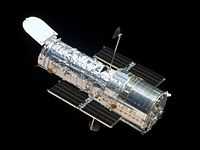
The Hubble Space Telescope is an excellent example of a radiation satellite designed for more than one purpose: the various astronomies of optical astronomy.
Astrometry
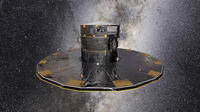
On the right is an image from an animation that has the Gaia spacecraft spinning slowly (four revolutions per day) to sweep its two telescopes across the entire celestial sphere.
Lunar Atmosphere and Dust Environment Explorer
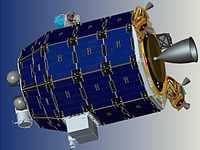
"The Lunar Atmosphere and Dust Environment Explorer (LADEE, at left) launched 07 September 2013 at 03:27 UT (06 September 11:27 EDT) on a Minotaur-V from Wallops Flight Facility."[29]
STEREO spacecraft
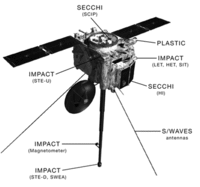
To produce 3D images of the Sun, the STEREO spacecraft [at right] take images in red and cyan.
Rosetta

The Rosetta Spacecraft has two instruments aboard that use green astronomy: the Optical, Spectroscopic, and Infrared Remote Imaging System (OSIRIS) and the Visible and Infrared Thermal Imaging Spectrometer (VIRTIS).
Terras
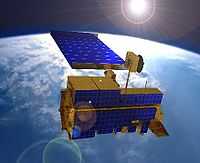
Composite images of the Sahara, a large yellow feature on Earth in the northern third of Africa, are mostly from the MODIS imager on board the Terra satellite.
Landsats
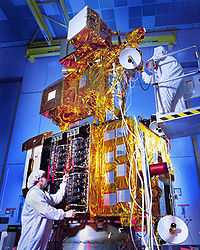
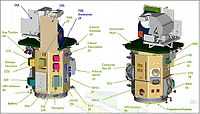
LandSat 7 is one of the most recent of the LandSat series of Earth observing satellites. It produced an orange astronomy image of the Namib Desert.
Spitzer Space Telescope
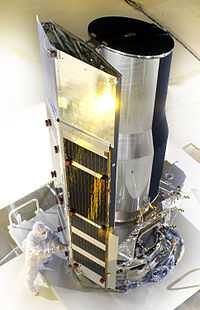
The Spitzer telescope is a Ritchey–Chrétien telescope.
Herschel Space Observatory
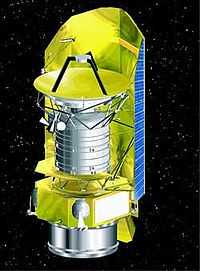
"The camera operates in three bands centred on 70, 100, and 160 μm, respectively, and the spectrometer covers the wavelength range between 51 and 220 μm."[30]
Submillimeter Wave Astronomy Satellite
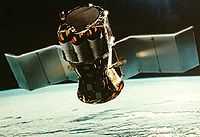
The Submillimeter Wave Astronomy Satellite "is a NASA Small Explorer Project (SMEX) designed to study the chemical composition of interstellar gas clouds."[31]
Planck
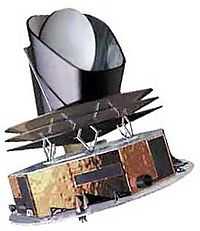
The Planck telescope was launched to observe the Cosmic Microwave Background Radiation (CMBR).
Aquarius
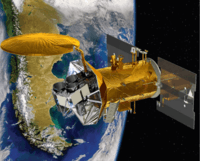
"Many natural sources, besides salinity, contribute to the microwave radiation at L-band frequencies (approximately 1 gigahertz) measured by satellites. Correcting the influence of these natural sources is a key to obtaining Aquarius’ accurate salinity measurements."[32]
TerraSAR-X
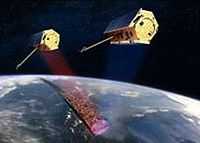
At the right is an artist's impression of the two radar satellites TerraSAR-X and TanDEM-X.
Research
Hypothesis:
- Astronomy performed from extremely high-altitude powered flight, or a glider, is a form of Earth-orbit astronomy.
Control groups

The findings demonstrate a statistically systematic change from the status quo or the control group.
“In the design of experiments, treatments [or special properties or characteristics] are applied to [or observed in] experimental units in the treatment group(s).[33] In comparative experiments, members of the complementary group, the control group, receive either no treatment or a standard treatment.[34]"[35]
Proof of concept
Def. a “short and/or incomplete realization of a certain method or idea to demonstrate its feasibility"[36] is called a proof of concept.
Def. evidence that demonstrates that a concept is possible is called proof of concept.
The proof-of-concept structure consists of
- background,
- procedures,
- findings, and
- interpretation.[37]
Proof of technology
"[T]he objective of a proof of technology is to determine the solution to some technical problem, such as how two systems might be integrated or that a certain throughput can be achieved with a given configuration."[38]
Def.
- "[a]n original object or form which is a basis for other objects, forms, or for its models and generalizations",[39]
- "[a]n early sample or model built to test a concept or process",[39] or
- "[a]n instance of a category or a concept that combines its most representative attributes"[39] is called a prototype.
Def. "[t]o test something using the conditions that it was designed to operate under, especially out in the real world instead of in a laboratory or workshop"[40] is called "field-test", or a field test.
A "proof-of-technology prototype ... typically implements one critical scenario to exercise or stress the highest-priority requirements."[41]
"[A] proof-of-technology test demonstrates the system can be used"[42].
"The strongest proof of technology performance is based on consistency among multiple lines of evidence, all pointing to similar levels of risk reduction."[43]
See also
References
- ↑ "satellite, In: Wiktionary". San Francisco, California: Wikimedia Foundation, Inc. June 19, 2012. Retrieved 2012-08-10.
- ↑ Sheldon (April 29, 2011). "Materials: Out of This World". Washington DC USA: NASA News. Retrieved 2014-01-08.
- ↑ "Alpha Magnetic Spectrometer, In: Wikipedia". San Francisco, California: Wikimedia Foundation, Inc. August 4, 2012. Retrieved 2012-08-10.
- ↑ "Extreme Universe Space Observatory, In: Wikipedia". San Francisco, California: Wikimedia Foundation, Inc. July 21, 2012. Retrieved 2012-08-23.
- ↑ Tony Choy (July 25, 2012). "Bonner Ball Neutron Detector (BBND)". Johnson Space Center, Human Research Program, Houston, TX, United States: NASA. Retrieved 2012-08-17.
- ↑ "Kibo (ISS module), In: Wikipedia". San Francisco, California: Wikimedia Foundation, Inc. August 1, 2012. Retrieved 2012-08-17.
- ↑ "Skylab 3, In: Wikipedia". San Francisco, California: Wikimedia Foundation, Inc. July 22, 2012. Retrieved 2012-08-17.
- ↑ Harlan E. Spence (August 16, 2013). "Van Allen Probe A (RBSP-A)". Washington, DC USA: National Space Science Data Center, NASA. Retrieved 2014-01-07.
- ↑ Dieter K. Bilitza (August 16, 2013). "Aeronomy of Ice in the Mesosphere". Washington, DC USA: National Space Science Data Center, NASA. Retrieved 2014-01-08.
- ↑ Christoph Seidler, translated by Anne-Marie de Grazia (19 June 2014). "Earth's weakening magnetic field". Q-Mag.org. Retrieved 2014-10-21.
- ↑ "Payload for Antimatter Matter Exploration and Light-nuclei Astrophysics, In: Wikipedia". San Francisco, California: Wikimedia Foundation, Inc. February 1, 2012. Retrieved 2012-08-10.
- ↑ "HEAO program, In: Wikipedia". San Francisco, California: Wikimedia Foundation, Inc. October 4, 2012. Retrieved 2013-05-09.
- ↑ D. J. Williams, T. A. Fritz, A. Konradi (August 1973). "Observations of proton spectra (1.0≤ Ep≤ 300 keV) and fluxes at the plasmapause". Journal of Geophysical Research 78 (22): 4751-5. doi:10.1029/JA078i022p04751. http://onlinelibrary.wiley.com/doi/10.1029/JA078i022p04751/full. Retrieved 2013-06-22.
- ↑ H. Kent Hills (June 14, 2013). "S-Cubed A". Greenbelt, Maryland USA: NASA Goddard Space Flight Center. Retrieved 2013-06-22.
- ↑ Ed Grayzeck (June 14, 2013). "S-Cubed A". Greenbelt, Maryland USA: NASA Goddard Space Flight Center. Retrieved 2013-06-22.
- ↑ Dave McComas and Lindsay Bartolone (May 10, 2012). "IBEX: Interstellar Boundary Explorer". San Antonio, Texas USA: NASA Southwest Research Institute. Retrieved 2012-08-11.
- ↑ W. N. Johnson (November 1996). "Appendix G to the NASA RESEARCH ANNOUNCEMENT for the COMPTON GAMMA RAY OBSERVATORY GUEST INVESTIGATOR PROGRAM". Greenbelt, Maryland USA: National Aeronautics and Space Administration Goddard Space Flight Center. Retrieved 2013-04-05.
- ↑ G. Weidenspointner, G.K. Skinner, P. Jean, J. Knödlseder, P. von Ballmoos, R. Diehl, A. Strong, B. Cordier, S. Schanne, C. Winkler (October 2008). "Positron astronomy with SPI/INTEGRAL". New Astronomy Reviews 52 (7-10): 454-6. doi:10.1016/j.newar.2008.06.019. http://www.sciencedirect.com/science/article/pii/S1387647308001164. Retrieved 2011-11-25.
- ↑ "Vela (satellite), In: Wikipedia". San Francisco, California: Wikimedia Foundation, Inc. June 27, 2012. Retrieved 2012-09-17.
- ↑ "Fermi Gamma-ray Space Telescope, In: Wikipedia". San Francisco, California: Wikimedia Foundation, Inc. June 9, 2012. Retrieved 2012-06-10.
- ↑ "Explorer 11, In: Wikipedia". San Francisco, California: Wikimedia Foundation, Inc. February 3, 2012. Retrieved 2012-12-05.
- ↑ "AGILE (satellite), In: Wikipedia". San Francisco, California: Wikimedia Foundation, Inc. May 2, 2013. Retrieved 2013-05-09.
- 1 2 TD Calderwood. "Highlights of NRL's First 75 Years".
- ↑ "X-ray astronomy satellites, In: Wikipedia". San Francisco, California: Wikimedia Foundation, Inc. May 10, 2012. Retrieved 2012-08-10.
- ↑ Henry A. Hoff (August 1983). "EXOSAT - The new extrasolar X-ray observatory". Journal of the British Interplanetary Society (Space Chronicle) 36 (8): 363-7. http://adsabs.harvard.edu/abs/1983JBIS...36..363H.
- ↑ "ALEXIS satellite marks fifth anniversary of launch". Los Alamos National Laboratory. 23 April 1998. Retrieved 17 August 2011.
- ↑ "Array of Low Energy X-ray Imaging Sensors, In: Wikipedia". San Francisco, California: Wikimedia Foundation, Inc. December 18, 2011. Retrieved 2012-12-09.
- ↑ D.J. Sahnow, et al. (1995-07-03). "The Far Ultraviolet Spectroscopic Explorer Mission". JHU.edu. Retrieved 2007-09-07.
- ↑ Richard C. Elphic, Sarah Noble, and P. Butler Hine III (September 7, 2013). "Lunar Atmosphere and Dust Environment Explorer (LADEE)". Washington, DC USA: National Space Science Data Center, NASA. Retrieved 2014-01-07.
- ↑ Edwin A. Bergin, Thomas Henning, Ewine van Dishoeck, Göran Pilbratt (January 30, 2013). "Herschel sizes up massive protoplanetary disc". European Space Agency. Retrieved 2013-02-01.
- 1 2 Brian M. Patten (June 28, 2005). "The Submillimeter Wave Astronomy Satellite (SWAS)". Cambridge, Massachusetts.: Harvard-Smithsonian Center for Astrophysics. Retrieved 2012-08-05.
- ↑ Rosemary Sullivant (May 31, 2011). "Aquarius Studying Our Salty Seas From Space". Pasadena, California USA: Jet Propulsion Laboratory, NASA. Retrieved 2014-01-08.
- ↑ Klaus Hinkelmann, Oscar Kempthorne (2008). Design and Analysis of Experiments, Volume I: Introduction to Experimental Design (2nd ed.). Wiley. ISBN 978-0-471-72756-9. http://books.google.com/?id=T3wWj2kVYZgC&printsec=frontcover.
- ↑ R. A. Bailey (2008). Design of comparative experiments. Cambridge University Press. ISBN 978-0-521-68357-9. http://www.cambridge.org/uk/catalogue/catalogue.asp?isbn=9780521683579.
- ↑ "Treatment and control groups, In: Wikipedia". San Francisco, California: Wikimedia Foundation, Inc. May 18, 2012. Retrieved 2012-05-31.
- ↑ "proof of concept, In: Wiktionary". San Francisco, California: Wikimedia Foundation, Inc. November 10, 2012. Retrieved 2013-01-13.
- ↑ Ginger Lehrman and Ian B Hogue, Sarah Palmer, Cheryl Jennings, Celsa A Spina, Ann Wiegand, Alan L Landay, Robert W Coombs, Douglas D Richman, John W Mellors, John M Coffin, Ronald J Bosch, David M Margolis (August 13, 2005). "Depletion of latent HIV-1 infection in vivo: a proof-of-concept study". Lancet 366 (9485): 549-55. doi:10.1016/S0140-6736(05)67098-5. http://www.ncbi.nlm.nih.gov/pmc/articles/PMC1894952/. Retrieved 2012-05-09.
- ↑ "Proof of concept, In: Wikipedia". San Francisco, California: Wikimedia Foundation, Inc. December 27, 2012. Retrieved 2013-01-13.
- 1 2 3 "prototype, In: Wiktionary". San Francisco, California: Wikimedia Foundation, Inc. December 8, 2013. Retrieved 2014-01-03.
- ↑ "field-test, In: Wiktionary". San Francisco, California: Wikimedia Foundation, Inc. August 5, 2012. Retrieved 2013-01-13.
- ↑ A. Liu; I. Gorton (March/April 2003). "Accelerating COTS middleware acquisition: the i-Mate process". Software, IEEE 20 (2): 72-9. doi:10.1109/MS.2003.1184171. http://cin.ufpe.br/~redis/intranet/bibliography/middleware/liu-cots03.pdf. Retrieved 2012-02-15.
- ↑ Rhea Wessel (January 25, 2008). "Cargo-Tracking System Combines RFID, Sensors, GSM and Satellite". RFID Journal: 1-2. http://www.rfidjournal.com/article/pdf/3870/1/1/rfidjournal-article3870.PDF. Retrieved 2012-02-15.
- ↑ P. Suresh, C. Rao, M.D. Annable and J.W. Jawitz (August 2000). E. Timothy Oppelt. ed. [http://www.afcee.af.mil/shared/media/document/AFD-071003-081.pdf#page=108 In Situ Flushing for Enhanced NAPL Site Remediation: Metrics for Performance Assessment, In: Abiotic In Situ Technologies for Groundwater Remediation Conference]. Cincinnati, Ohio: U.S. Environmental Protection Agency. pp. 105. http://www.afcee.af.mil/shared/media/document/AFD-071003-081.pdf#page=108. Retrieved 2012-02-15.
External links
![]() This is a research project at http://en.wikiversity.org
This is a research project at http://en.wikiversity.org
| |
Resource type: this resource is an article. |
| |
Resource type: this resource contains a lecture or lecture notes. |
| |
Subject classification: this is an astronomy resource. |